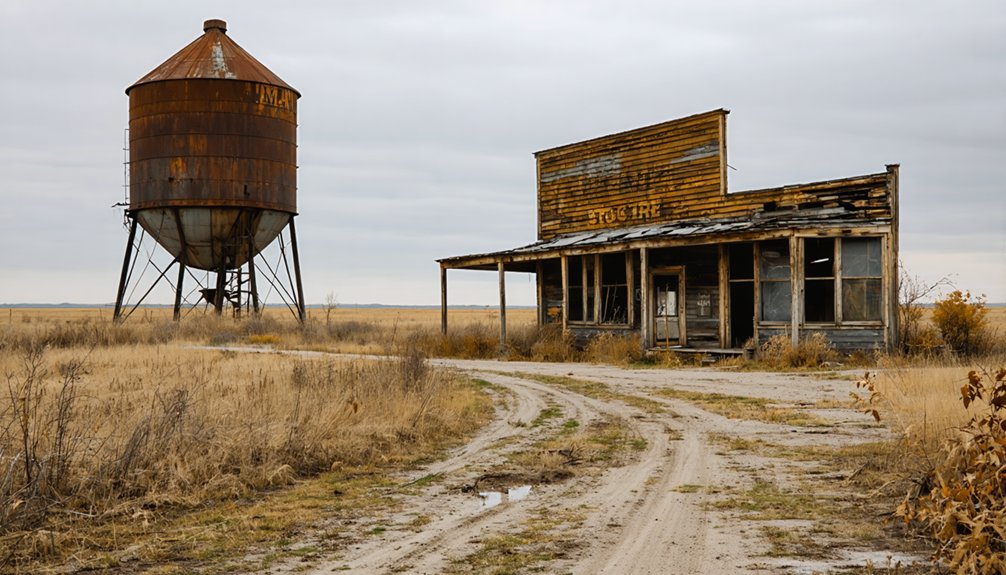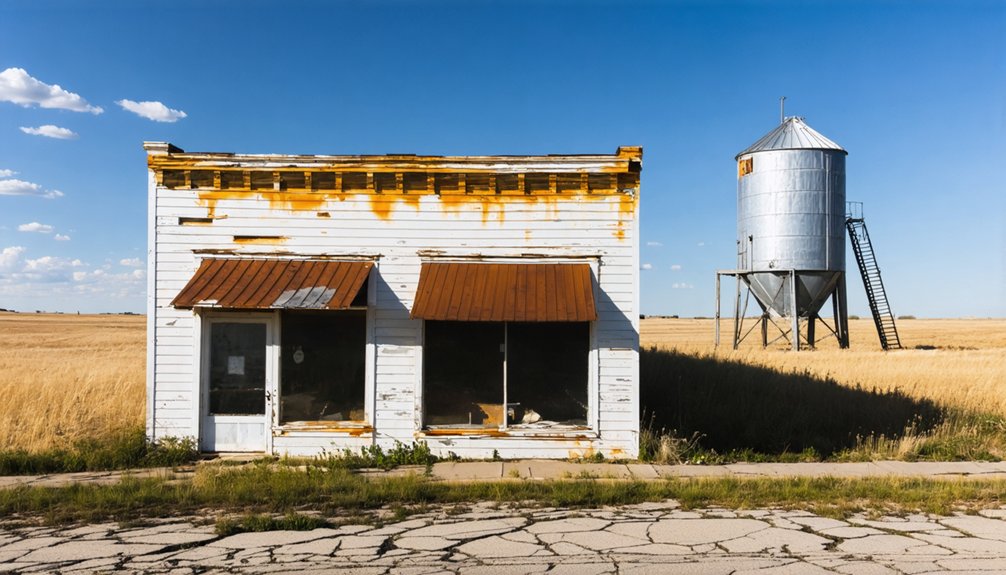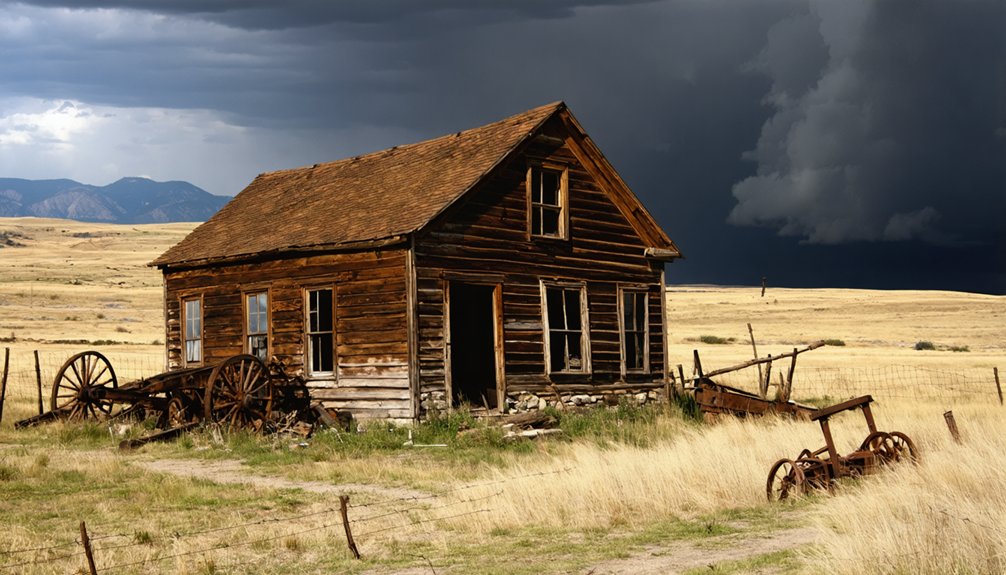You’ll find Albany’s ghost town ruins 50 miles southeast of Rapid City, where weathered storefronts and a deteriorating train depot tell the story of South Dakota’s railroad era. Founded in 1836, this former agricultural hub reached its peak in the early 1900s with about 100 residents, thriving on grain shipments and livestock trade. Today, the abandoned buildings, worn cemetery headstones, and crumbling Main Street facades reveal fascinating glimpses into Dakota Territory’s pioneering spirit.
Key Takeaways
- Albany was established in 1836 in Lee County, South Dakota, and reached its peak population of about 100 residents in the early 1900s.
- The town thrived due to its railroad facilities, sawmill operations, and agricultural activities before economic changes led to its decline.
- Remaining structures include the historic railroad station, merchant buildings along Main Street, and a cemetery with 1880s headstones.
- The ghost town’s decline was primarily caused by mechanization of agriculture, reduced farming jobs, and diminished railroad importance.
- Located 50 miles southeast of Rapid City, Albany can be explored independently but offers no visitor facilities or marked paths.
Origins and Early Settlement
When Palmyra’s bustling frontier community laid the groundwork, Albany, South Dakota emerged in 1836 as a strategic settlement in Lee County.
The area’s development paralleled that of ancient Syrian Palmyra, drawing inspiration from the historical city’s name and legacy.
You’ll find that settler motivations centered on the region’s fertile plains and promising trade routes, which supported their dreams of prosperity through agricultural practices and commerce.
The settlement quickly established itself with essential services matching Palmyra’s robust infrastructure. You could find a church, school, doctor’s office, and various commercial enterprises including a general store and blacksmith shop.
The cornerstone of local industry was Watson’s Cotton Gin Factory, alongside a grist mill that capitalized on the area’s natural resources.
These early developments showcased the determination of pioneers to create a self-sustaining community in the northern plains, building on the success of their predecessor, Palmyra.
Like many South Dakota towns, the community’s fate was heavily influenced by the railroad expansion that transformed the region’s landscape.
Life in Albany’s Glory Days
During Albany’s peak years in the early 1900s, you’d find a tight-knit community of roughly 100 residents bustling around the town’s sawmill, mining operations, and railroad facilities. Life centered around daily work at these sites, with families living in modest wooden homes nearby.
You wouldn’t have missed the chapel’s prominent presence, where community events brought everyone together for services and celebrations. The local Lutheran and Methodist churches hosted family gatherings, while cafes and filling stations served as social hubs. Much like in Wild West Deadwood, life had its share of unsavory characters drawn by the promise of mining riches. Like many other settlements in the region, Albany’s eventual decline came as trucking replaced railroads for shipping goods.
Children attended the town school, and neighbors helped each other through challenging times, including the devastating 1918 influenza pandemic. Most families supplemented their income through small-scale farming and ranching, creating a self-reliant atmosphere typical of rural Black Hills towns of that era.
Railroad’s Role in Town Development
When the railroad laid tracks through South Dakota’s eastern plains in the late 1800s, you’d find Albany strategically positioned as one of its promising new stops. The steam locomotive era that began in Chicago had steadily expanded westward through the Midwest.
You could see the daily bustle around Albany’s depot as it handled freight shipments, telegrams, and passenger service while serving as the town’s essential communication hub.
During the railroad’s peak years, you’d witness a steady stream of grain-laden cars and merchandise moving through Albany’s rail yard, marking the town’s economic heyday before the rise of automobile culture. Like many other communities, the town’s local speculators invested heavily in anticipation of the economic prosperity the railroad would bring.
Railroad Construction Impact
The arrival of railroad lines in the 1880s fundamentally shaped Albany’s development, as it did for countless other South Dakota towns. Like many settlements of that era, Albany’s fate hinged on railroad routes that could either bring prosperity or doom a community to obscurity.
The strategic placement of tracks often reflected speculative strategies by railroad investors who saw opportunities in undeveloped land. Population growth soared from 11,776 to 263,411 between 1870 and 1885 as rail networks expanded across the territory.
You’ll find that rail construction brought more than just tracks – it transformed Albany’s economic landscape. As trains began running through the region, they created crucial links to distant markets for local farmers and merchants.
The railroad’s influence extended beyond transportation, determining the town’s layout with the characteristic T-shaped design and positioning of key facilities like grain elevators and warehouses along the tracks.
Station Operations Daily Life
Station life in Albany revolved around the bustling depot, where the station agent‘s daily duties kept the town connected to the wider world. You’d find the agent juggling multiple responsibilities throughout the day, from selling tickets to managing essential telegraph communications that brought news from distant places.
Station management wasn’t just about paperwork – it meant coordinating with local farmers and merchants for freight operations, making sure their grain and livestock made it onto the right cars at the right time. The revival of rail service in 2005 through a BNSF haulage agreement helped ensure continued grain transport operations for the region.
The depot served as your community’s lifeline, with the agent tracking train schedules and orchestrating the loading and unloading of critical supplies. Inside the waiting room, you’d catch up on local happenings while the steady click of the telegraph reminded you of your connection to the broader commercial network beyond Albany’s borders.
Freight Traffic Peak Years
During the late 1800s through early 1900s, Albany’s rail lines surged with unprecedented freight activity as South Dakota’s mining and agricultural boom transformed the region.
You’d have seen bustling freight routes connecting Albany to essential Black Hills mining towns and agricultural centers, with cargo volumes reaching historic highs. The town’s strategic location along these routes made it a significant hub for shipping grain, livestock, mining ore, and important supplies.
Albany’s commercial district grew around the depot, where warehouses and sidings handled the constant flow of goods. The rail infrastructure revolutionized local commerce, offering year-round transport that was cheaper and more reliable than traditional methods.
You could’ve witnessed the J.B. Haggin locomotive hauling heavy freight trains, marking an era of technological advancement in Albany’s peak years.
Economic Forces Behind the Decline

Multiple economic forces converged to doom Albany’s existence as a viable South Dakota community in the early 20th century.
You’ll find that major economic changes hit the town from several directions – the mechanization of agriculture reduced farming jobs, while alterations in ranching operations severely impacted the livestock economy that had been Albany’s lifeblood.
When the railroad’s importance diminished, the town lost its crucial transportation link for cattle shipments and agricultural products.
These transformations triggered significant population shifts as residents sought opportunities elsewhere.
Like many communities established during the Homestead Act of 1862, settlers initially flocked to Albany with dreams of prosperity and new beginnings.
The Great Depression dealt the final blow, accelerating the exodus of families and businesses.
Like many small South Dakota communities, Albany couldn’t sustain itself as traditional agricultural practices, ranching operations, and rail transport underwent dramatic evolution in the modern era.
Today, only abandoned buildings and artifacts remain to chronicle the town’s once-vibrant history.
Notable Buildings and Landmarks
You’ll find the once-bustling railroad station’s skeletal remains standing sentinel at Albany’s northern edge, its weathered timber frame and collapsed platform hinting at the town’s railroad heritage.
Walking down what was once Main Street, you can spot the deteriorating facades of former merchant buildings, their false fronts still reaching skyward despite decades of harsh Dakota winters.
The town’s cemetery, situated on a quiet hill overlooking Albany, features worn headstones dating from the 1880s through the early 1900s, telling silent stories of the community’s pioneers.
Historic Railroad Station Remains
As testimony to Albany’s railroad heritage, the remains of its historic station stand as a crucial landmark from the town’s late 19th-century peak.
The station’s railroad architecture followed typical South Dakota depot designs, featuring wooden construction with dedicated spaces for passengers, freight, and telegraph operations. You’ll find remnants of the original foundation and fragments of the main structure, which once anchored the town’s bustling agricultural commerce.
When you explore the site today, you’ll notice how the station’s strategic position near the main line shaped Albany’s early development.
While preservation efforts have been limited, the deteriorating remains tell a compelling story of the railroad’s influence on the region’s settlement and eventual decline. The site serves as a poignant reminder of how railroad decisions could make or break frontier towns.
Main Street Building Ruins
The deteriorating buildings along Albany’s Main Street paint a stark portrait of the town’s bygone prosperity.
You’ll find architectural features that showcase early 20th-century designs, from false-front storefronts to the remnants of a once-bustling hotel. Time and neglect have taken their toll, with structural decay evident in collapsed roofs and rotting wooden frames.
- Former Methodist and Catholic churches stand as silent sentinels, their stained glass frames and modest steeples now mere shadows.
- A weathered bank vault and thick foundation walls hint at the town’s financial center.
- Crumbling storefronts reveal faded painted signs of general stores and saloons.
- Residential ruins dot the landscape, their chimneys rising above deteriorating clapboard walls.
The buildings’ current state serves as a haunting reminder of Albany’s shift from thriving community to ghost town.
Local Cemetery Site
Beyond Main Street’s architectural remnants lies Albany’s historic cemetery, a somber memorial to the town’s earlier inhabitants.
You’ll find this sacred ground nestled near the original townsite, featuring scattered grave markers that tell tales of the community’s past. The cemetery once boasted the stunning Consecration Lake and a cherub fountain that shot water thirty feet skyward, though these features have long since vanished.
Cemetery legends abound in this historic burial ground, where locals report encounters with the mysterious Gray Lady and spectral black dogs.
You might hear stories of a ghostly horse still galloping along the old carriage paths, or glimpse unexplained lights near the Superintendent’s Cottage.
While private ownership now limits access, the cemetery’s weathered monuments and stone foundations continue to preserve Albany’s rich cultural heritage.
Stories From Former Residents
Personal accounts from Albany’s former residents paint a vivid picture of small-town life in early 20th century South Dakota.
You’ll hear stories of resilience through hardship, from the devastating 1919 influenza outbreak to the economic struggles that followed the sawmill’s closure. Their resident remembrances often blend historical facts with tales of ghostly encounters in abandoned homes, creating a rich tapestry of communal memory.
- Daily life centered around the post office and local businesses, where neighbors gathered to share news.
- Families relied heavily on lumber mill work and cattle trading for their livelihoods.
- Community events and schools served as the heart of social interaction.
- The town’s decline left deep emotional scars, with many residents carrying stories of multigenerational loss and perseverance.
Albany’s Legacy in South Dakota History

Mining towns like Albany left an indelible mark on South Dakota’s historical landscape, serving as a microcosm of the state’s boom-and-bust development during the Black Hills mining era.
You’ll find Albany’s legacy woven into the broader fabric of heritage preservation efforts, where its remains tell the story of railroad-driven prosperity and subsequent decline.
The town’s cultural significance extends beyond its physical remnants, illustrating how communities adapted to changing economic forces. From its role in the regional transportation network to its tight-knit social structure, Albany represents a vital chapter in South Dakota’s development.
The transformation of old railroad grades into recreational trails guarantees that you can still connect with this piece of Black Hills history, even as the town itself has faded into memory.
Visiting the Ghost Town Today
Today’s visitors to Albany ghost town encounter a remote, atmospheric site that demands careful preparation and respect for its deteriorating structures.
You’ll find yourself 50 miles southeast of Rapid City, exploring the scattered ruins of this privately-owned property on foot. Ghost town exploration here reveals abandoned buildings, including an old motel and church, best photographed during early morning or late afternoon light.
Venture 50 miles from Rapid City to discover Albany’s haunting remains, where abandoned motels and churches await the photographer’s eye.
- Bring all necessary supplies as there aren’t any visitor facilities or amenities
- Check property ownership and obtain permission before exploring the site
- Consider visitor safety by watching for unstable structures and uneven terrain
- Plan your visit during ideal lighting conditions for photography
The absence of marked paths and interpretive signs means you’ll need to rely on self-guided discovery while maintaining respect for this fragile piece of South Dakota’s history.
Frequently Asked Questions
Were There Any Significant Crimes or Shootouts in Albany’s History?
You won’t find documented crime incidents or shootout history in Albany. Historical records show it was a peaceful farming community, unlike nearby towns Deadwood and Bannack that experienced notorious criminal activity.
What Native American Tribes Originally Inhabited the Albany Area?
You’ll find the powerful Oceti Sakowin (Sioux) peoples were the primary inhabitants, with Dakota and Lakota bands dominating this tribal land. Their rich history in eastern South Dakota spans thousands of years.
Did Albany Have Any Connection to Famous Historical Figures?
You won’t find famous residents or historical landmarks tied to nationally known figures in Albany’s history. Unlike nearby Deadwood, this small Black Hills settlement didn’t attract legendary personalities or notable pioneers.
What Was the Highest Recorded Population of Albany?
Precise population peaks prove peculiarly difficult to pinpoint. Historical demographics suggest you’d find only one house there, with population trends indicating you wouldn’t see more than a handful of residents throughout its existence.
Were There Any Natural Disasters That Contributed to Albany’s Decline?
You won’t find clear evidence of flood impact or drought effects causing Albany’s decline. Historical records suggest economic factors, like railroad changes and shifting agricultural patterns, were the main reasons people left.
References
- https://usghostadventures.com/deadwood-ghost-tour/
- https://www.sdhspress.com/journal/south-dakota-history-2-2/some-black-hills-ghost-towns-and-their-origins/vol-02-no-2-some-black-hills-ghost-towns-and-their-origins.pdf
- https://www.sdpb.org/rural-life-and-history/2023-08-21/some-black-hills-ghost-towns-and-their-origins
- https://www.youtube.com/watch?v=_0WNYsFLSLA
- https://www.youtube.com/watch?v=Glucs_Rq8Xs
- https://www.powderhouselodge.com/black-hills-attractions/fun-attractions/ghost-towns-of-western-south-dakota/
- https://www.blackhillsbadlands.com/blog/post/old-west-legends-mines-ghost-towns-route-reimagined/
- https://en.wikipedia.org/wiki/List_of_ghost_towns_in_South_Dakota
- https://www.onlyinyourstate.com/experiences/south-dakota/capa-ghost-town-sd
- https://icatchshadows.com/okaton-and-cottonwood-a-photographic-visit-to-two-south-dakota-ghost-towns/



